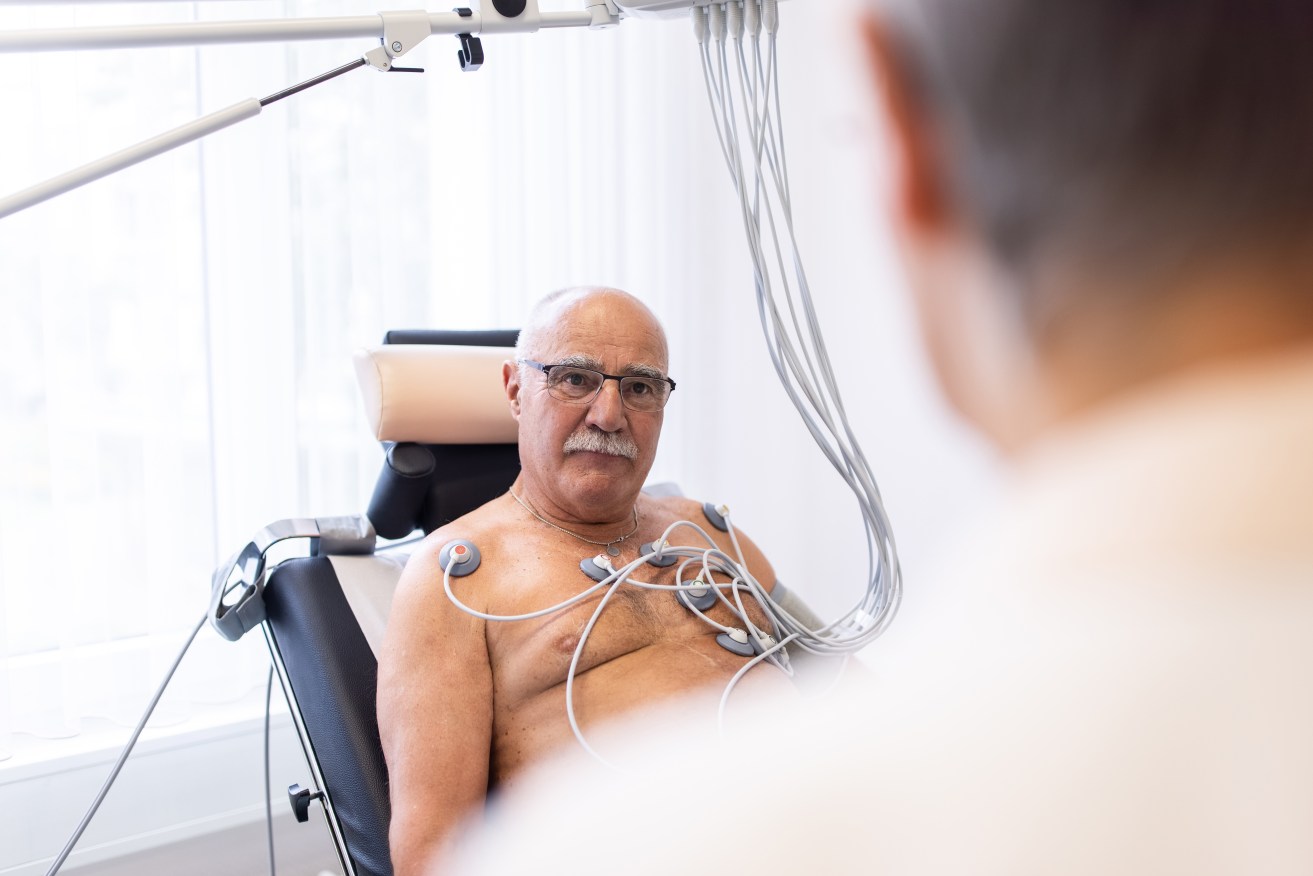Get an ECG, older folk – you might have atrial fibrillation


An ECG is a simple, non-invasive test that can reveal if you have atrial fibrillation or other heart conditions. Photo: Getty
How is your heartbeat going? No worries?
Maybe. Or maybe not.
You might have a friend who has been diagnosed with atrial fibrillation, the most common arrhythmia or irregular heart rhythm.
An unreliable heartbeat means an unreliable blood supply to your organs, including your brain and lungs.
That’s why they weren’t looking the best for a while. That’s why they complained of fatigue, feeling breathless, and being a little scared by their racing heart.
All of these, and more, are symptoms of atrial fibrillation (AF).
Poor chap.
Did he or she mention how they were staring down the increased risk of heart failure, stroke or a clot in the heart? Probs not.
The doctors are on top of it.
There’s a range of treatment options to suit your friend’s condition. Life can go on for a good while yet. Exercise and all.
All they needed was to be diagnosed.
Phew
You, on the other hand, have no symptoms.
Therefore, it seems there’s no reason to believe that you have AF.

Atrial fibrillation is recorded by the green line on the monitor. Photo: Getty
Sorry to spoil that sense of security. But a significant number of people are walking around with AF, and are clueless to the fact.
Because they have no symptoms.
Which is a problem
What you might have, then, is Silent Atrial Fibrillation (SAF).
It’s commonly referred to as a silent killer.
This is because people with SAF are at a greater risk of a catastrophic event such as heart failure or a stroke. And more.
A 2014 critical review of Silent Atrial Fibrillation concluded:
“Despite all the current efforts, SAF is still widely under-diagnosed in every day clinical practice. Unfortunately, prevalence of this disease is not trivial and enough data suggest that SAF could predispose to a higher risk of thrombo-embolic events.”
Thrombo-embolic events are when a blood clot forms in a deep vein. As previously mentioned, these can end up in the heart or the brain.
It’s reckoned that up to 30 per cent of people living with the condition remain undiagnosed.
How many people have AF?
According to the Australian Institute of Health and Welfare (AIHW):
“There are no national data sources that report on the total number of Australians who have AF.”

During AF, the heart has disorganised electrical signals.
But it’s thought that AF affects about 2 per cent of the population. That was more than half a million people in 2020, according to the AIHW.
This rough guess that the AIHW relies on is based on surveys and studies on sections of the Australian population.
Age is the primary risk factor for AF. The older you get, the greater the chance your heartbeat will go wobbly.
As the AIHW reports: “Rates of AF in international studies suggest that an estimated 5.4 per cent of Australian adults aged 55 years and older had AF in 2014.”
Do you know about this?
Chances are you missed the frivolity and excitement of Atrial Fibrillation Awareness Week. That was in late September.
Fair enough. There were the footy finals to think of.
But according to hearts4heart – a support, advocacy and education charity for people living with heart disease – one-in-three Australian adults are “completely unaware of atrial fibrillation”, a condition responsible for one-in-four strokes.
The charity reports that one-in-three Australians are at risk of developing atrial fibrillation in their lifetime, increasing not only their risk of stroke and heart failure, but also dementia.
What happens with atrial fibrillation?
According to the Heart Foundation: “In atrial fibrillation, abnormal electrical activity in the top chambers of the heart overwhelms the heart’s own pacemaker (part of its electrical system) and the conduction messages become chaotic.”
“This causes the heart’s top two chambers (atria) to twitch rather than contract. The atria twitch rapidly and out of rhythm with the heart’s lower two chambers (ventricles).”
As a result, your heart beats in a fast and irregular way.
This reduces your heart’s ability to pump blood properly. It also increases the chance of blood clots forming in your heart and travelling up to your brain, where it can cause a stroke.
Atrial fibrillation is a progressive disease. This means that it gets worse over time.
However, atrial fibrillation is not usually life-threatening when it’s properly treated.
Causes of atrial fibrillation
According to the Mayo Clinic, problems with the heart’s structure are the most common cause of AF.
These issues include:
- A congenital heart defect
- A problem with the heart’s natural pacemaker, called sick sinus syndrome
- Obstructive sleep apnea
- Heart attack
- Heart valve disease
- High blood pressure
- Lung diseases, including pneumonia
- Narrowed or blocked arteries, called coronary artery disease
- Thyroid disease such as an overactive thyroid
- Infections from viruses
- Heart surgery or stress due to surgery or sickness may also cause AF. Some people who have atrial fibrillation have no known heart disease or heart damage.
Lifestyle triggers
Behaviours that can trigger an episode include:
- Drinking too much alcohol or caffeine
- Illegal drug use
- Smoking or using tobacco
- Taking medicines that contain stimulants, including cold and allergy medicines bought without a prescription.
For risk factors, see here.
What to do now?
The Australian government’s health advice is that people aged 45 years or above (or 35 years or above for Aboriginal and/or Torres Strait Islander people) should ask their doctor to assess their heart disease risk.
This assessment should include an electrocardiogram (ECG) which will record your heartbeat and indicate whether or not you might have AF.
Some doctors may not refer patients for an ECG if they don’t have symptoms.
This is where you need to advocate for yourself, by raising the issue that a significant number of people with AF show no symptoms.
For more about how AF is diagnosed, see here.








